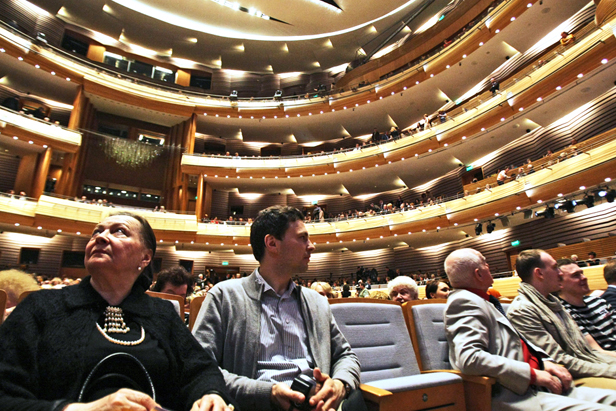Mariinsky's new stage causes debates among theatre fans


The new Mariinsky Theatre in St. Petersburg, called the Mariinsky II, has been a decade in the making and dogged by false starts and controversy. The distinctive glass and limestone building opened in May with a lavish gala attended by a former resident, President Vladimir Putin.
Reuters
The new theater sits in the heart of historic St. Petersburg and its modernist structure is accentuated by the auditorium’s enveloping wall of amber-colored onyx. The mineral, shipped in from Italy, Iran, Macedonia and Turkey, serves as a beacon to the music-loving public.
AP
The 2,000 seat concert hall is a signature work designed by Canadian architect Jack Diamond, who placed great emphasis on maximizing the acoustic experience and creating a sense of intimacy.
Rossiyskaya Gazeta
The hall, for instance, has only three balconies instead of the standard four or five. In combination with the original theater, and a concert hall finished in 2006, it creates what even The New York Times called a “St. Petersburg arts complex with the scope and versatility of Lincoln Center.”
ITAR-TASS
The foyer is decorated with glowing, honey-yellow onyx and studded with chandeliers made from Swarovski diamonds, boasting a cascade of glass staircases rising into the air. It does indeed make a strong impression. The theatre’s staff promises that, in the evenings, when daylight will not counteract the lighting of the expensive stone, the sense of luxury will be even greater.
Rossiyskaya Gazeta
Public areas have been designed as an integral and complementary component of the building and create a sense of dramatic arrival and fluid movement. A variety of staircases thread through the foyer, including a dramatic 33-metre architectural glass staircase that traverses the north side of the foyer, connecting every above-ground level of the building. The foyer is split into several individual spaces of various sizes.
Pauline Narychkina
The Mariinsky II has been designed to create ideal acoustic conditions. At about 18000 m3, the hall has an ideal volume and is comparable to the world’s most renowned opera houses. The auditorium’s floor is separated from the concrete foundations by sound-absorbing wooden structures. Solid wood balustrades arranged in an overlapping sequence with embedded light fixtures are located throughout the auditorium to aid sound diffusion.
Reuters
The orchestra pit is equipped with a moveable acoustic wall developed to allow for varying orchestral and acoustic needs. At full capacity, the pit is 170 m2 and holds up to 120 musicians. The pit is also equipped with three platforms: a smaller one in the rear and two larger ones in the front. These can be raised or lowered to different levels depending on the instrumentation and the desired sound.
Rossiyskaya Gazeta
The new theater can stage three performances daily and will have much less downtime between major productions. It is all part of Gergiev’s plans to make St. Petersburg a major international center for the arts, and a draw for traveling groups from major foreign theaters.
Rossiyskaya Gazeta
At the gala performance, there was an array of talent and samples from the Mariinsky’s rich history and current roster, including a recreation of Nijinsky’s iconic and lyrical “Rite of Spring.”
Rossiyskaya Gazeta
Placido Domingo performed “Winterstürme” from Wagner’s Siegmund.
Rossiyskaya Gazeta
Opera star Anna Netrebko offered a preview of an upcoming performance of Verdi’s Lady Macbeth.
Rossiyskaya Gazeta
The gala coincided with Gergiev’s 60th birthday party, and his patron led the celebration. "A man endowed with truly unending creative energy, brilliant, inimitable Maestro,” Putin said in a birthday telegram, adding that the conductor is "one of the outstanding musicians of our time."
RIA NovostiAll rights reserved by Rossiyskaya Gazeta.
Subscribe
to our newsletter!
Get the week's best stories straight to your inbox